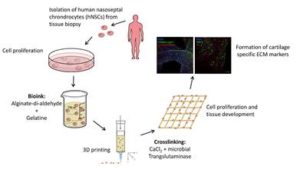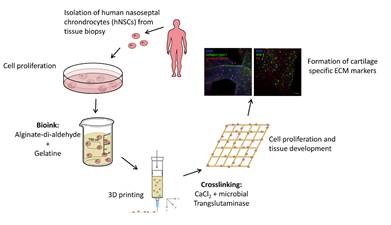3D printed alginate-di-aldehyde/gelatin dual crosslinked hydrogel for cartilage tissue engineering: new publication
Our new paper entitled “3D printing and characterization of human nasoseptal chondrocytes laden dual crosslinked oxidized alginate-gelatin hydrogels for cartilage repair approaches” [1] has been published in the journal Materials Science and Engineering C. This is the result of a collaboration led by Dr. Silke Schwarz and Prof. Gundula Schulze-Tanzil of the Department of Anatomy and Cell Biology, Paracelsus Medical University (PMU), Nuremberg and Salzburg, Nuremberg. In this work we investigated the applicability of an alginate-di-aldehyde (ADA) and gelatin (GEL), dual crosslinked hydrogel system for cartilage tissue engineering.We showed that neither the printing procedure nor the dual crosslinking had a harming effect on primary human nasoseptal chondrocytes. The formation of cartilage specific markers, including collagen type II, proteoglycans and SOX9, especially induced by the enzymatic crosslinking, was demonstrated by immunohistochemistry.
[1] S. Schwarz, S. Kuth, et al., 3D printing and characterization of human nasoseptal chondrocytes laden dual crosslinked oxidized alginate-gelatin hydrogels for cartilage repair approaches, Mater. Sci. Eng. C 116 (2020) 111189.


